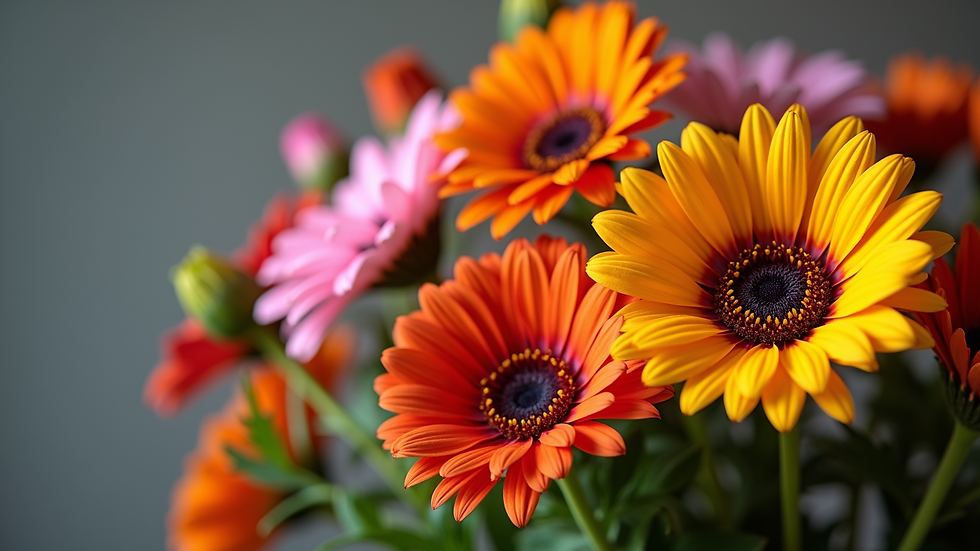Unveiling the Secrets of Floriography: The Language of Flowers in Ancient Festivals and Modern Magick
- koadofthecrossroad
- May 17
- 4 min read
Flowers have always been more than just beautiful adornments; they hold deep meanings and serve as symbols of life, growth, and connection across cultures. Take May, named after Maia, the Roman goddess of growth and abundance. This month is laden with significant festivals that highlight the ways people revered the language of flowers. From the Rosalia, the Festival of Roses, to the sacred celebrations in Ireland and the Norse Feast of Frigg, flowers have been essential in bridging the gap between the earthly and the spiritual.
As we look at these colorful festivals of May, we will uncover the charming world of floriography—the language of flowers—and how this ancient practice can benefit current magickal traditions.
The Blossoming of May Festivals
As spring unfolds, May showcases a rich tapestry of cultural festivals, each one celebrating the beauty and significance of flowers. The Rosalia, a Roman festival, is dedicated to roses that symbolize love, passion, and beauty. These qualities make roses a fitting symbol for this joyous occasion.
In Ireland, the Veneracion of the Sacred Thorn honors a miraculous thorn that represents faith. In Norse culture, the Feast of Frigg celebrates love, fertility, and domesticity. These festivals remind us that flowers are not merely aesthetics; they tell stories that span generations.
Other festivals like Garland Day in England and Lei Day in Hawaii contribute regional charm to the flower celebrations, both emphasizing community and our relationship with nature. The Celtic celebration of Beltane further highlights flowers as symbols of fertility and renewal, revealing how societies have connected with nature’s cycles since ancient times.
The Enchantment of Floriography
Flowers have a unique language known as floriography, which conveys deep meanings and emotions. This art thrived during the Victorian era when individuals exchanged nosegays and tussie-mussies as a way to express feelings without words. The beauty of floriography is in its ability to turn flowers into a form of communication that speaks directly to the heart.
Each flower carries its own message, creating a personalized vocabulary for various occasions. For example, a man might give a bouquet with Canterbury bells for gratitude, pink dianthus for pure love, and lemon balm to highlight friendship. Likewise, a wedding bouquet could include red roses for love, lavender for commitment, and ivy for fidelity, solidifying its significance.
Flowers as Magical Tools
Floriography plays a vital role in enhancing spells and rituals, making it a valuable aspect of magick. The journey starts with clear intention; the user must know what they wish to achieve. Next comes selecting flowers that embody the intended message. Finally, there are numerous methods to weave these floral symbols into practice.
One could create a floral altar for a specific purpose or incorporate flowers into candle spells as well as potions. Others may choose to infuse flowers into sacred objects or even design floral mandalas to focus on during meditation. The many ways to integrate floriography into spiritual practices serve as a reminder that the natural world holds many gifts.

Revitalizing an Ancient Art in Modern Times
Today's world may not recognize floriography as it once was, but it remains relevant for anyone wishing to add beauty and intention to their lives. By tuning into the messages nature provides, the once-overlooked art of floriography offers ways to express emotions and foster connections.
Getting started with floriography is simple. Begin by learning what different flowers symbolize. For example, sunflowers represent adoration, marigolds signify creativity, and violets denote loyalty. With some research, individuals can create a personal floriography dictionary representing their beliefs and values.
Creating thoughtful floral arrangements that reflect specific emotions is a hands-on way to engage with floriography. Whether gifting meaningful blooms or using them in personal rituals, flowers serve as a gentle way to express complex feelings.
The Intersection of Nature and Intention
Celebrating ancient festivals rich in tradition, we must acknowledge the enduring legacy of these customs and the crucial role of flowers. The universal values of growth, connection, and beauty can thrive today through floriography.
The language of flowers presents a unique chance to link past, present, and future, allowing practitioners to connect with the subtle aspects of nature. Flowers are not just decor; they are powerful channels of emotion, healing, and intention.
Incorporating this captivating art into our lives fosters a deeper understanding of the natural world and the many ways it influences us. By reviving the practice of floriography, we embrace the richness of human experience, forging pathways that illuminate our intentions through nature's vibrant gifts.
Final Thoughts
The lively festivals of May and the magical language of flowers emphasize that enchantment exists beyond spells and rituals. By deepening our understanding of floriography and its application in contemporary magick, we forge a unique bond with the natural world—one that invites healing, love, and abundance into our lives.
May your exploration of this floral language prosper. Let your intentions reach the universe, revealing the profound sentiments that flowers hold. Embrace the magic of flowers and listen closely to their silent messages; they speak volumes in nature's gentle whispers.



Comments